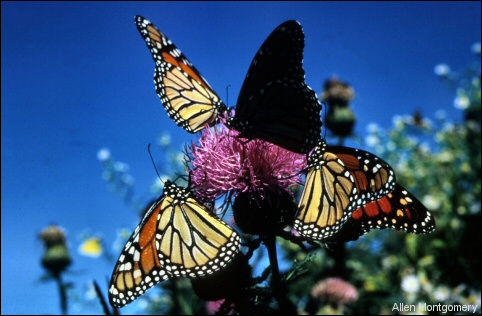
Monarch Butterflies are not an important part of the northern Chihuahuan Desert's fauna, but nevertheless occur as strays or migrants. The ability of these butterflies to migrate long distances from anywhere in the United States to a single, small region deep in Mexico has long fascinated biologists. We've known that the sun plays a part in allowing the butterflies to orient themselves, but using the sun as a compass has a problem. You have to know what time it is, because the sun appears to move through the sky. A sun slightly above a horizon could signify either east or west, depending on whether it was morning or afternoon; you'd be able to know which only if you knew the time.
By exposing butterflies to an artificial "day" shifted 6
hours early, researchers found the butterflies reacted to the real sun as if it were in
the direction expected 6 hours later and attempted to migrate to the southeast rather
than the correct southwest. Once, you might have asked, "What's time to a
butterfly?" Now you know!

Contributor: Arthur H. Harris, Laboratory for Environmental Biology, Centennial Museum, University of Texas at El Paso.
Desert Diary is a joint production of the Centennial Museum and KTEP National Public Radio at the University of Texas at El Paso.

Monarch Butterflies clustered on a thistle. Photograph by Allen Montgomery, courtesy of the U.S. Fish and Wildlife Service.
Pennisi, E. 2003. Monarchs check clock to chart migration route. Science 300:1216-1217.